The story of Dachau, as told to touristsBaracke X - Disinfection Chambers and Ovens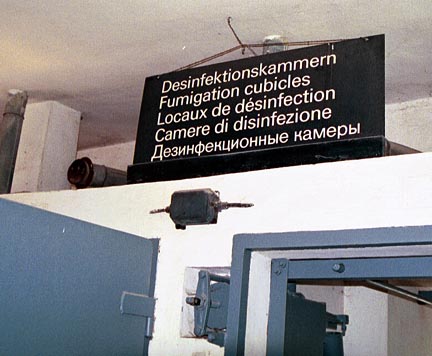 There are also four small gas chambers at Dachau that were used to disinfect the clothing with the same poison gas that was used for gassing the Jews. In the disinfection chambers, the Zyklon-B pellets were dumped into a wire basket and warm air was blown into the room in order to quickly release the gas. The homicidal gas chamber at Dachau did not have a device for blowing warm air into the room, yet one guide with an "Irish accent" told his tour group that it did. The following quote is from a blog written by a young visitor to Dachau: The guide spoke of how they cleverly pumped warm air into the room, waited for the poisonous capsule to change to cyanide and then 20 minute for the people to die. Then they moved the bodies into the next room and removed the gold fillings. Finally onto the ovens. Although there is a black sign with white letters near the ceiling which says "Fumigation cubicles" in five languages, many visitors still think these cubicles were used for homicidal gassing. Just after I finished taking the above photograph in May 2003, a tour group entered the corridor and an English-speaking guide told the students: "When a transport of Jews was brought to Dachau, they had to remove their clothes, and then they entered these chambers where they were gassed." The photo below shows the clothing that American soldiers found hung up outside the disinfection chambers when Dachau was liberated on April 29, 1945. They assumed that the Jews had been forced to hang their clothes on hangers before going inside the disinfection chambers to be gassed to death. 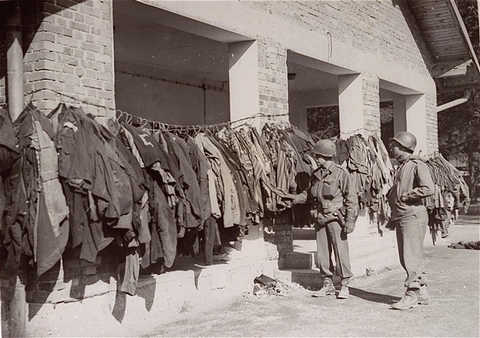 A recent visitor to the Dachau Memorial Site put up a web site with lots of nice photos. One of the photos on the web site shows the black and white sign above the disinfection gas chambers and another photo similar to my photo below which shows the two doors of one of the disinfection chambers. 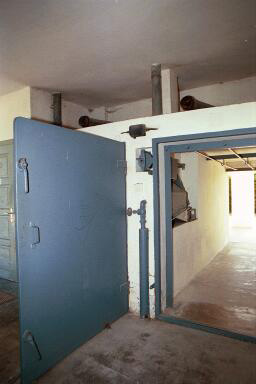 The following quote is from the web site which has these captions on two photos of the disinfection chambers: I went through the crematorium the way a prisoner would go through it. First was the fumigation. The double door fumigation rooms. Prisoners would enter from the other end with their clothes on. They were fumigated to kill typhus and lice because their clothes were going to be reused by other prisoners. They don't want the other prisoners to die too, right? Plus it turned out that Zyklon-B is absorbed faster when prisoners are fumigated first. Contrary to the misleading information quoted above, which this visitor was told by a misguided tour guide, the "Fumigation cubicles" were only used to kill the lice in the prisoner's clothing after the prisoners had taken off their clothes. The prisoners did not enter the Fumigation cubicles; if they had, they would have been killed by the Zyklon-B that was used to disinfect the clothing. The disinfection cubicles had wide doors at each end in order to air out the room for 20 hours after the disinfection of the clothing with Zyklon-B was completed. The incoming prisoners were taken to the large shower room in the building that now houses the Museum. First, they were dipped into a large bathtub of disinfectant, followed by a shower, after which all the hair on their bodies was shaved off and they were given clean clothes that had been disinfected with Zyklon-B. This was done to prevent the spread of disease. 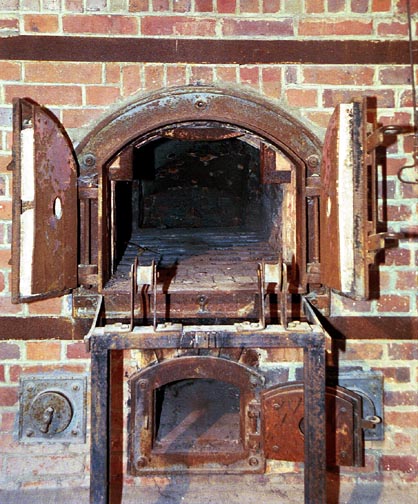 The greatest shock to visitors is the ovens in the crematorium in Baracke X. A close-up of one of the ovens is shown in the photo above. The small door on the oven was used for removing the ashes, not for putting live babies inside, as some people mistakenly believe. The cremation ovens were fired by coke; they were not gas ovens used for killing the Jews. The ovens were used only for burning dead bodies. Tourists are not told that the bodies were burned in an effort to stop the spread of disease, nor that the ovens in the Baracke X building were only used by the Nazis between April 1943 and October 1944. Half of the prisoners who perished at Dachau died in the typhus epidemic after these ovens were no longer in use because of the shortage of coal. Yet visitors are told by the guides that the Nazis were murdering the inmates as fast as they could in the last days of the war, knowing that time was running out because the camp would soon be liberated. One guide told her group that the prisoners who worked in the crematorium were killed every three months in order to eliminate the witnesses to the "Final Solution." The Dachau ovens were fired up again by the Americans after the Dachau camp was liberated, according to Marcus J. Smith, a US Army doctor, who wrote a book entitled "The Harrowing of Hell." Smith wrote that the former crematorium workers, who were still very much alive, complained to him in a letter that the Americans were not treating them in the privileged manner to which they had become accustomed when the SS ruled the camp. 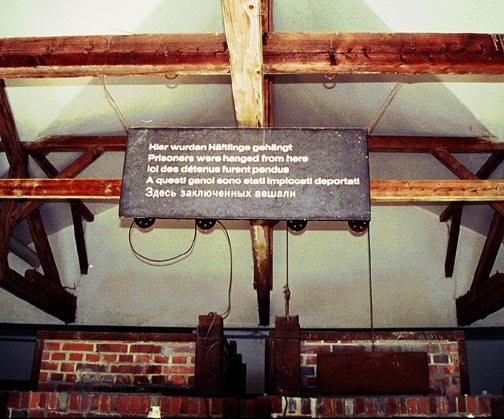 The photo above shows a sign that says in 5 languages that "Prisoners were hanged from here." Dead bodies were hung in front of the ovens to keep the bodies straight before they were cremated. Notice that there is a pulley in front of each oven to hang a dead body. A sign on the north wall of the crematorium tells visitors: Most hangings were carried out here. They were hanged directly in front of the burning oven. A memorial plaque on the ground outside the crematorium denotes the spot where Dachau prisoners, who had been condemned to death, were executed by hanging. 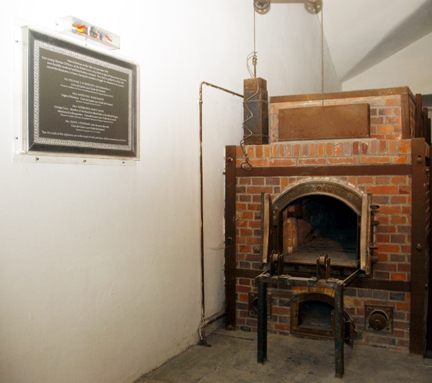 On the south wall of the crematorium, right next to one of the ovens, hangs a plaque honoring four female British SOE agents: Noor Inayat Khan, Yolanda Beekman, Elaine Plewman, and Madeleine Damerment. Visitors to Dachau are told that these four women were brought to Dachau, a men's camp, and secretly executed. Visitors are not told that the six male British SOE agents at Dachau, who had higher ranking positions in the SOE, all survived not only Dachau, but several other camps. The wording on the plaque honoring the SOE agents, shown in the photo above reads as follows: 1944, four young woman officers of the British forces attached to Special Operations Branch were brutally murdered and their bodies cremated. They died as gallantly as they had served the Resistance in France during the common struggle for freedom from tyranny. After learning about the gas chamber and the torture of the prisoners at Dachau, the comment that is most frequently expressed by visitors to Dachau is "How could human beings have treated other human beings so horribly?" The following quote from an article entitled "Never Again," written several years ago by Joe McCain, the brother of John McCain, sums it up nicely: "I stood in the center of Dachau for an entire day, about 15 years ago, trying to comprehend how this could have happened. I had gone there on a side trip from Munich, vaguely curious about this Dachau. I soon became engulfed in the enormity of what had occurred there nestled in this middle and working class neighborhood. How could human beings do this to other human beings, hear their cries, their pleas, their terror, their pain, and continue without apparently even wincing?" Dachau Museum & BunkerRefugee Camp at DachauEntrance to Memorial SiteArbeit Macht Frei gateInternational Monument & Unknown PrisonerDachau MemorialsGas chamberBack to Dachau Concentration CampBack to Table of ContentsHomeThis page was last updated on October 24, 2009 |